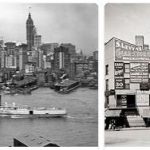Demographics
| Population development | |||||||||||||||||||||||||||||||||||||||||||||||||||||||||||||||
|
|
||||||||||||||||||||||||||||||||||||||||||||||||||||||||||||||
Immigrants arrive at Ellis Island, in New York. Photo from 1902
According to itypemba, New York is the most populous city in the United States, with 8,363,710 residents as of July 1, 2008 (down from 7.3 million in 1990). This number makes up about 40% of the total population of New York State and about the same percentage within the metropolitan area. Over the past decade, the population has grown and New York is expected to have between 9.2 million and 9.5 million inhabitants by 2030.
Two important demographic characteristics are population density and cultural diversity. The city’s population density is 10,194 inhabitants per km², which is the highest density of all municipalities in the United States with a population greater than 100,000. Manhattan’s population density is 25,846 per square kilometer, which is the highest density of any region in the United States.
New York has a high degree of income inequality: in 2005, the median household income in the richest census area was $188,697, while in the poorest area it was $9,320. This inequality has been exacerbated by continued salary increases for the upper-income class, while the wages of the middle and low-income classes have stagnated. In 2006, the median weekly salary in Manhattan was $1453, the highest and fastest growing salary among the largest counties in the United States.This borough is experiencing a baby boom, a unique feature for an American city. Since 2000, the number of children under five in Manhattan has increased by 32%.
Home ownership in New York is much lower than the national average of 69% at about 33%. The percentage of vacant rental housing is usually between 3% and 4.5%. This is below the 5% limit used to determine that there is a housing problem. It is used as a justification to control and stabilize part of the rental market. About 33% of rents are regulated by the government. Finding housing, especially affordable housing, can be very difficult in New York.
Religion
New York is a multicultural city and the city is also very diverse in religious terms. At the time of Dutch rule, only the Nederduitse Gereformeerde Kerk (later Dutch Reformed Church) was allowed. Non-reformed inhabitants, such as the Quakers, were even persecuted by the government (Peter Stuyvesant) for their dissenting religious views.
The city remained Protestant for a long time after British rule and American independence. Only with the arrival of large groups of immigrants from Italy and Ireland did Roman Catholicism become visible in everyday life. This created a lot of suspicion among Protestants, who saw the new breed of immigrants as a threat to their freedom and independence. They believed that the Catholics would mainly listen to the authority of the Pope and many anti -pope riots arose.
In the second half of the 19th century, large groups of Chinese migrated to the city. These immigrants built their own religious buildings in the Chinatowns. Mostly, these were Chinese temples that contained a mixture of China’s three major religions: Confucianism / Ancestor Worship, Chinese Buddhism, and Taoism. It was not until the 20th century that separate Buddhist temples, Taoist temples and a Confucius temple were built.
Population origin
Chinatown in Manhattan
The population of New York is very diverse. Throughout its history, the city has always been an important arrival point for new immigrants from many countries. The term melting pot was first used to describe the composition of the densely populated immigrant neighborhoods on the Lower East Side. Today, 36% of New York’s population is born outside the United States. Of the US cities, this number is exceeded only by Los Angeles and Miami. While in those cities the immigrant communities are dominated by a small number of nationalities, in New York no country or region of origin dominates. The ten largest home countries of contemporary immigration are the Dominican Republic, China, Jamaica, Guyana, Mexico, Ecuador, Haiti, Trinidad and Tobago, Colombia, and Russia. About 170 different languages are spoken in the city.
The New York metropolitan area has the largest Jewish community outside of Israel. In 2000, more than one million Jews lived in New York. This is the largest Jewish community in the world, larger than Tel Aviv ‘s. About 15% of New Yorkers are Jewish. In addition, nearly a quarter of Indian Americans and the largest African American community of any city in the United States also live in New York.
The five largest ethnic groups according to the 2005 census are: Puerto Ricans, Italians, West Indians, Dominicans, and Chinese. The Puerto Rican population in New York is the largest outside of Puerto Rico. Italians emigrated to the city in large numbers in the early twentieth century. There are also many people of Irish descent: they are the sixth largest ethnic group. There are three Chinese neighborhoods in New York. The Chinese neighborhoods are again subdivided on the jiaxiang of the Chinese Americans. Due to strong segregation, many neighborhoods are dominated by a certain population group.
Crime
Since 2005, the city has had the lowest crime rate of the 25 largest US cities, making it significantly safer after the crime peaks of the 1980s and 1990s. In 2002, New York had one of the lowest crime rates of any US city with a population greater than 100,000. Violent crime in the city fell more than 75% from 1993 to 2005, while crime rates rose across the United States.In 2005, the number of homicides was at its lowest level since 1963. In 2007, there were fewer than 500 homicides, the first since crime figures began to be published in 1963.
Sociologists and criminologists disagree on the causes of the decline in crime rates. Some say it’s because of the New York City Police Department ‘s new tactics. Others look for the cause in the decreased use of cocaine, or in demographic changes.
New York has long been associated with organized crime. It started with the Forty Thieves and the Roach Guards, two Irish street gangs that were active in the Five Points slum around 1820. In the 20th century, the mafia dominated by the Five Families emerged. Gangs, such as the Black Spades, made their appearance towards the end of the 20th century.








